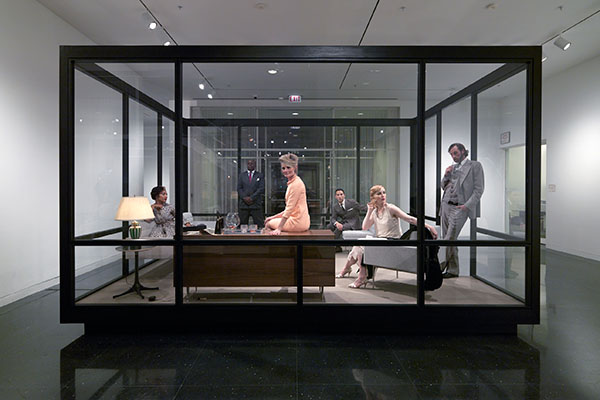Call them the patron puppeteers. For the last 100 years, wealthy art enthusiasts have been building Chicago’s international art presence— including museums filled with Parisian loot and public plazas adorned with privately funded monuments—from within the walls of old-money social clubs; The Arts Club of Chicago is a favorite among this Chicago coterie.
For the past 97-years, the elite institution has hosted the likes of Duchamp, Chagall, and Dali, and this fall, the Gold Coast space is home to the New York-based artist Josiah McElheny's exhibition, Two Clubs at The Arts Club of Chicago. The show takes a satirical look at the elite institution by placing the highest symbol of transparency—a glass house—within the club’s first-floor exhibition space. That is, a mock glass house made of steel beams and glass walls, designed in collaboration with architect John Vinci—a mimicry of the modernist glass boxes designed by mid-century Chicago architect Ludwig Mies van der Rohe.
Chicagoans may know the trained glassblower from his several shows at the Donald Young Gallery before it recently closed, or his 1998 show at the Art Institute Chicago, or from his 2006 MacArthur "genius" grant.
McElheny’s glass house is not a far cry from his glassblowing trade, but what happens inside is where things get interesting. The artwork, titled The Club for Modern Fashions, requires public participation in order to function correctly. McElheny calls upon volunteers to don vintage drag—from the 1920s through the 1970s—and perform, silently, within the glass house; the zoo-like performance is McElheny's searing look at members-only clubs and high society at-large. Once volunteers finish their hour-long stint, they are escorted upstairs for a free lunch and cocktail amid the club’s members.
McElheny and I sat inside the glass house one recent morning, before the day’s performers showed up. “The great thing about being an artist,” said McElheny, “is that you can get away with a lot of things.” He was referring to his oblique, tongue-in-cheek critique of arts patronage and philanthropy. In an adjacent gallery, McElheny showed a mock documentary about an actual tycoon, James Deering. McElheny got a kick when his viewers couldn’t define what was real and what was exaggerated within the film. Both the glass house and the film blur the line between the absurd and the plausible, made all the more complicated by eccentric millionaires.
“The whole nature of class is deeply embedded in this gallery and this institution,” said McElheny about the Arts Club. “I like the idea of the whole thing being disturbed and called to task from the class issue,” said McElheny. “I hope that students will do that, and get the free lunch and cocktail.”
“The Club for Modern Fashions” is on view at the Arts Club of Chicago, 201 E Ontario, through December 13. Performances take place Tuesday—Friday, 11:30am—12:30pm. For volunteer opportunities, visit artsclubchicago.org.



